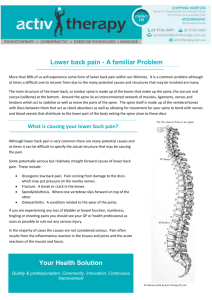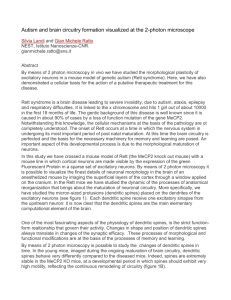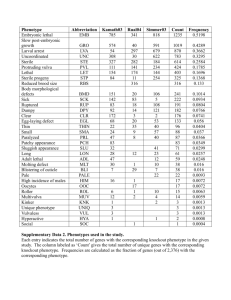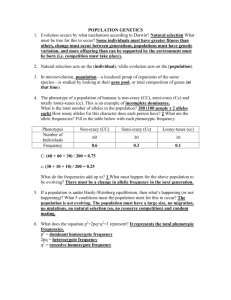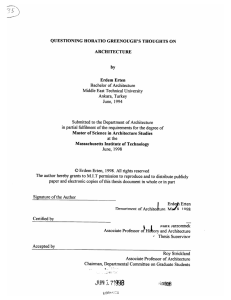morphological phenotype - The University of Illinois Archives
advertisement
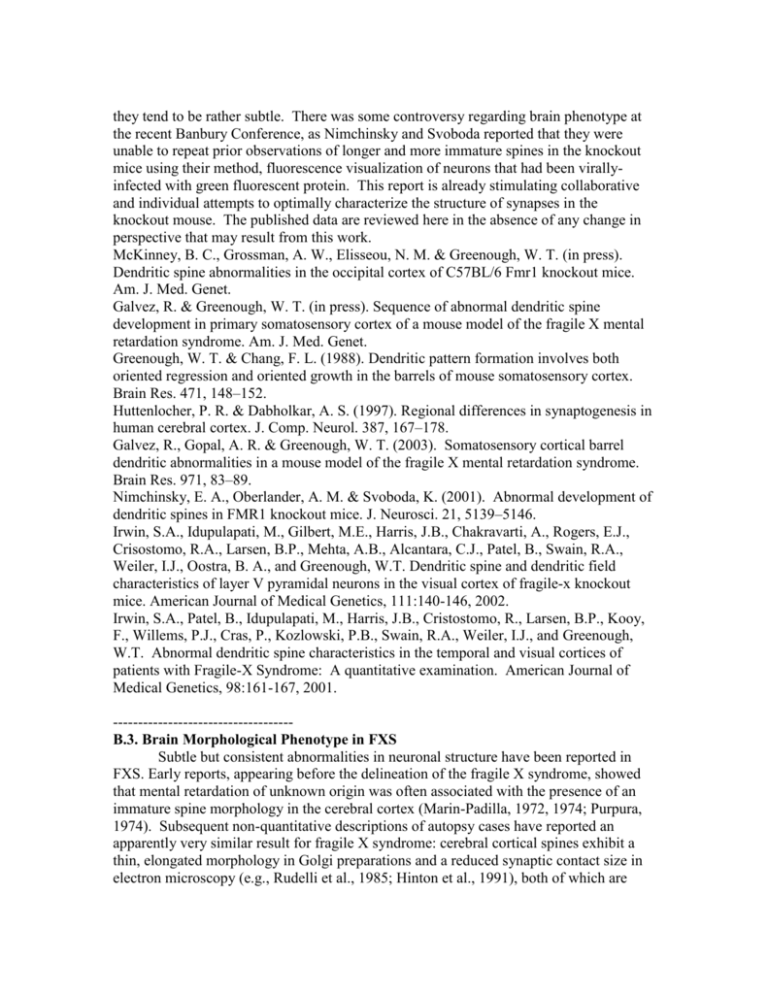
they tend to be rather subtle. There was some controversy regarding brain phenotype at the recent Banbury Conference, as Nimchinsky and Svoboda reported that they were unable to repeat prior observations of longer and more immature spines in the knockout mice using their method, fluorescence visualization of neurons that had been virallyinfected with green fluorescent protein. This report is already stimulating collaborative and individual attempts to optimally characterize the structure of synapses in the knockout mouse. The published data are reviewed here in the absence of any change in perspective that may result from this work. McKinney, B. C., Grossman, A. W., Elisseou, N. M. & Greenough, W. T. (in press). Dendritic spine abnormalities in the occipital cortex of C57BL/6 Fmr1 knockout mice. Am. J. Med. Genet. Galvez, R. & Greenough, W. T. (in press). Sequence of abnormal dendritic spine development in primary somatosensory cortex of a mouse model of the fragile X mental retardation syndrome. Am. J. Med. Genet. Greenough, W. T. & Chang, F. L. (1988). Dendritic pattern formation involves both oriented regression and oriented growth in the barrels of mouse somatosensory cortex. Brain Res. 471, 148–152. Huttenlocher, P. R. & Dabholkar, A. S. (1997). Regional differences in synaptogenesis in human cerebral cortex. J. Comp. Neurol. 387, 167–178. Galvez, R., Gopal, A. R. & Greenough, W. T. (2003). Somatosensory cortical barrel dendritic abnormalities in a mouse model of the fragile X mental retardation syndrome. Brain Res. 971, 83–89. Nimchinsky, E. A., Oberlander, A. M. & Svoboda, K. (2001). Abnormal development of dendritic spines in FMR1 knockout mice. J. Neurosci. 21, 5139–5146. Irwin, S.A., Idupulapati, M., Gilbert, M.E., Harris, J.B., Chakravarti, A., Rogers, E.J., Crisostomo, R.A., Larsen, B.P., Mehta, A.B., Alcantara, C.J., Patel, B., Swain, R.A., Weiler, I.J., Oostra, B. A., and Greenough, W.T. Dendritic spine and dendritic field characteristics of layer V pyramidal neurons in the visual cortex of fragile-x knockout mice. American Journal of Medical Genetics, 111:140-146, 2002. Irwin, S.A., Patel, B., Idupulapati, M., Harris, J.B., Cristostomo, R., Larsen, B.P., Kooy, F., Willems, P.J., Cras, P., Kozlowski, P.B., Swain, R.A., Weiler, I.J., and Greenough, W.T. Abnormal dendritic spine characteristics in the temporal and visual cortices of patients with Fragile-X Syndrome: A quantitative examination. American Journal of Medical Genetics, 98:161-167, 2001. -----------------------------------B.3. Brain Morphological Phenotype in FXS Subtle but consistent abnormalities in neuronal structure have been reported in FXS. Early reports, appearing before the delineation of the fragile X syndrome, showed that mental retardation of unknown origin was often associated with the presence of an immature spine morphology in the cerebral cortex (Marin-Padilla, 1972, 1974; Purpura, 1974). Subsequent non-quantitative descriptions of autopsy cases have reported an apparently very similar result for fragile X syndrome: cerebral cortical spines exhibit a thin, elongated morphology in Golgi preparations and a reduced synaptic contact size in electron microscopy (e.g., Rudelli et al., 1985; Hinton et al., 1991), both of which are also characteristic of the immature, or the experience-deprived synapse in the cerebral cortex. A detailed quantitative study revealed a similar spine shape phenotype and also revealed that spine density (number per unit dendrite length) was higher in FXS patients than in matched controls (Irwin et al., 2001). Hinton et al. (1991) noted that neither gross pathology nor any indication of cell migratory failures or neuronal density changes is associated with fragile X syndrome, in contrast to a variety of other mental retardation syndromes (including Down syndrome). Thus while "dendritic spine dysgenesis" also occurs in other mental deficiency syndromes, it is the only cellular-level neuropathology thus far found in fragile X syndrome (Irwin et al., 2001). A similar spine morphology appears to be present, perhaps less dramatically, in fragile X knockout mice (Comery et al., 1997; Irwin et al., 2002; McKinney et al., in press). These spine abnormalities were reported to diminish in the somatosensory barrel cortex during development (Nimchinsky et al., 2001), but recent research indicates that the abnormalities re-emerge as the mice mature (Galvez and Greenough, in press). (The oldest mice in the Nimchinsky et al. study were 27 days postnatal, and Galvez and Greenough saw the phenotype re-emerge between that age and adulthood, during a period when spine density diminished in WT control mice.) The excess of long, thin, immature-looking spines has been hypothesized to reflect impairment of a pruning process that would normally eliminate excess spines during development, and that normally contributes to the development of patterned brain circuitry (Huttenlocher et al,, 1997). In a region of the somatosensory whisker barrel cortex where dendrites are normally withdrawn during development (Greenough and Chang, 1988), the improperly located dendrites are not withdrawn in FMR1-knockout mice (Galvez et al., 2003), and diminishing spine density parallels development of the spine shape phenotype from postnatal week 4 to adulthood (Galvez and Greenough, in press). Combined with additional evidence for the spine phenotype in a different genetic background mouse strain (McKinney et al., in press) the weight of the evidence supports the view that the neuromorphological abnormalities that are seen in both fragile X syndrome and the mouse model involve, at least in part, a failure to prune synapses and parts of dendrites that would normally be eliminated during development. A phenotype on the axonal side of the synapse in the dentate gyrus may similarly arise from a pruning failure (Ivanco and Greenough, 2002). (The preceding summary was presented at the 2005 Banbury meeting.) In addition to these differences in fine structure, there are also deficits in gross brain morphology. Reiss, et al. (e.g., 1994) has found some brain regions to be larger and others reduced in FraXS patients. was fatally flawed by the inclusion of an unknown number of subjects with a retinal degeneration syndrome, additional reports have shown a mild morphological phenotype in the KO mouse that parallels that seen in humans (Irwin et al., in prep.).

